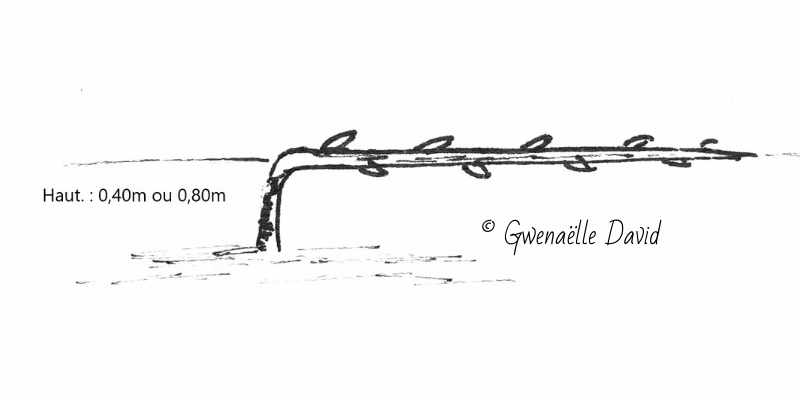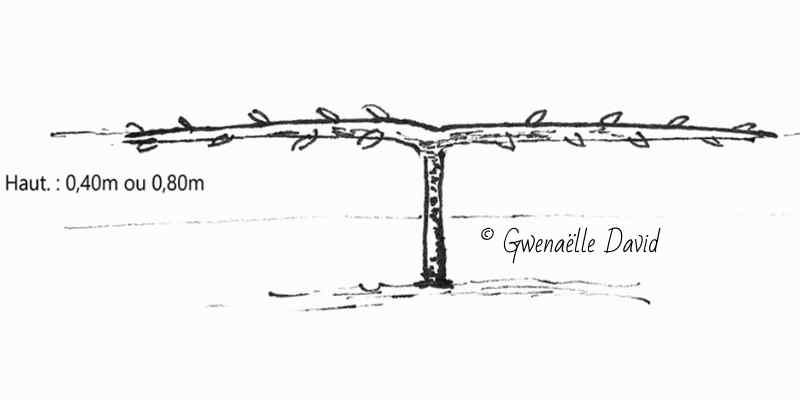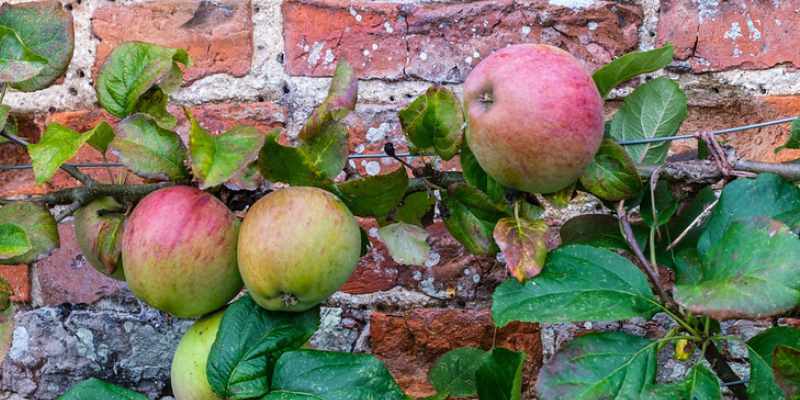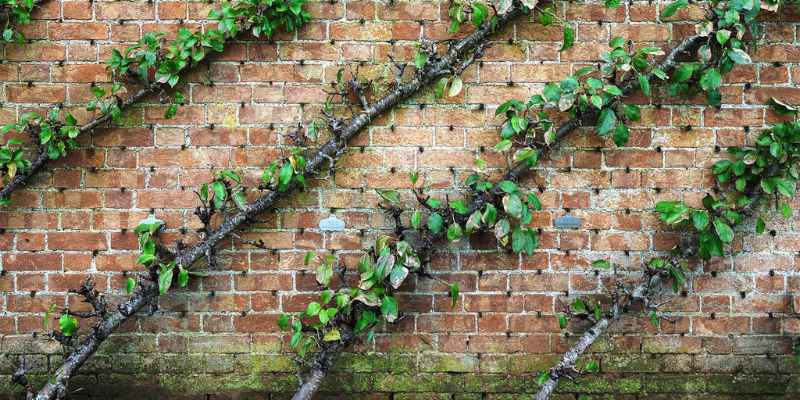If you are a gardening enthusiast looking for new ways to optimise space while harvesting tasty fruit, then training a fruit tree as a cordon is a technique not to be missed. Originating from French and British orchard culture, this age-old method will help you maximise yield while adding a unique aesthetic touch to your garden. So, prepare your pruning shear and put on your gloves, because we are about to dive into fascinating world of cordon training!
What is the "cordon" form?
Cordon training pruning is a horticultural technique specifically designed for fruit trees, especially apple trees and pear trees or even grapevine (Royat cordon pruning). This method is ideal for maximising fruit production in small gardens, as it allows control of tree vertical and horizontal growth. With careful pruning, the tree takes on a linear, horizontal shape, similar to a "cordon", hence the name of the technique.
By choosing cordon pruning, gardeners can enjoy several benefits. First, this method promotes better air circulation and greater sun exposure, optimal conditions for fruit development. It also makes maintenance and harvest much easier, because fruit are more accessible. It is also an ingenious solution for confined spaces, such as terraces or balconies, where room for large trees is limited.
However, cordon pruning requires rigorous maintenance and good skills in pruning fruit trees. Incorrect pruning can lead to unbalanced growth or even compromise tree health. It is therefore crucial to follow best gardening practices and, if possible, consult experts for advice specific to your situation.
Different types of cordon
Cordon training pruning offers several variations to suit specific garden needs. Among the most common are the single cordon and the two-armed cordon.
The single cordon is characterised by a single main stem that extends horizontally, often supported by a trellis or other structure. This configuration is particularly useful for very narrow gardens or for growing fruit trees along a wall. The single cordon is also easier to maintain, as it requires less pruning and branch training. It allows better sun exposure across whole tree, which can speed fruit ripeness.

In contrast, the two-armed cordon features a central stem from which two main branches extend horizontally. This method can produce slightly higher yields because of the increased number of fruit buds. However, it requires wider space and more meticulous maintenance to keep balance between the two arms. Pruning must be done carefully to prevent one arm becoming more vigorous than the other, which could unbalance tree.

There are other cordon pruning variants that offer solutions adapted to different gardening needs and spaces. For example, the oblique cordon, also known as the inclined cordon, involves tilting main stem at an angle rather than leaving it completely horizontal. This method is particularly effective at encouraging fruiting along stem, as it mimics more natural growth form for tree.
Another interesting variant is the spiralled cordon, where main stem is formed into a kind of spiralled shape around a support. This method is often used for grapevines, but can also apply to certain types of fruit trees. It allows very efficient use of vertical space, which can be beneficial in gardens where ground space is limited.
Which fruit trees can be trained as cordons?
Cordon training is particularly well suited to certain types of fruit trees. Apple trees and pear trees are most commonly chosen for this type of pruning, but other fruit trees can also be successfully grown as cordons. These include cherry trees, plum trees, apricot trees, peach trees, almond trees and even some types of citrus trees. It is also possible to train fruit bushes such as redcurrant and blackcurrant bushes as cordons, although this is less common. Finally, grapevine lends itself very well to cordon pruning.
Each type of fruit tree has its own needs and characteristics, which can affect how it responds to cordon pruning. For example, fast-growing apple varieties may need more frequent pruning to maintain desired shape, whereas pear trees, generally slower growing, may require fewer interventions.
Choice of rootstock should not be underestimated, as some are better suited to controlled growth than others. Low-vigour rootstocks are most appropriate for cordon forms, because they allow better control of tree size. They also encourage earlier fruiting, which is an undeniable advantage for gardeners eager to harvest fruit. For apple trees, rootstocks such as M9 or M26 are often recommended for cordon culture. For pear trees, Quince C is a popular choice due to its low vigour and good adaptability to different soil conditions.

How to train a fruit tree as a cordon?
Apple tree as a single cordon
After planting, remove most lateral branches, leaving only a single main stem. Tie this stem to a solid horizontal support, such as a wire stretched between two posts or a trellis. The aim is to train the stem so it grows horizontally rather than vertically. Make sure stem is tied securely but not too tightly to avoid damage.
Pruning is best carried out in late winter, when tree is in dormancy. Remove lateral shoots that develop along main stem, leaving only fruit buds. These buds will produce fruit the following season. It is also crucial to remove any vertical growth so tree energy focuses on fruit production rather than height growth.
Apple tree as a two-armed cordon
At planting, leave about one metre between trees if you plan to create several two-armed cordons. Once tree is planted, remove all lateral branches, keeping only main stem. Allow this stem to grow vertically during first year, supporting it with a sturdy stake.
In winter, when tree is in dormancy, select two opposite branches near top of main stem to form two arms of cordon. Prune all other branches to direct plant energy to these two arms. Then tie the two selected branches to a horizontal support, such as a wire or trellis, so they develop horizontally on each side of main stem.
Apple tree as an oblique cordon
Once tree is planted, prune all lateral branches, keeping only main stem. Tie this stem to the inclined support using soft but strong ties. As tree grows, continue to attach main stem along support, following angle of inclination.

Maintenance of a cordon-trained fruit tree
Aside from usual fruit tree care (watering, fertilising, pest care...), pruning is a crucial aspect of cordon maintenance. This should be carried out during dormancy, in late winter for apple and pear trees, for example. The aim is to remove any vertical growth or any branch that could divert resources from main branch. Also remember to prune lateral shoots, leaving only fruit buds to encourage fruiting.
Also check ties and support system regularly. They must be strong and in good condition to support tree growth and fruit weight.
Necessary equipment
- Pruning shear : used for cutting branches and lateral shoots.
- Pruning saw : useful for larger cuts or removing thicker branches.
- Stake : to support main stem during early growth stages.
- Wire or trellis : used as horizontal support to guide tree growth.
- Soft ties : to attach main stem and branches to support without damaging them.
- Gardening gloves : to protect hands during pruning and other tasks.
- Measuring tape or ruler : to measure distances at planting, especially if planting several cordon trees.
- Garden labels : to identify varieties and note care given to each tree.
































Comments